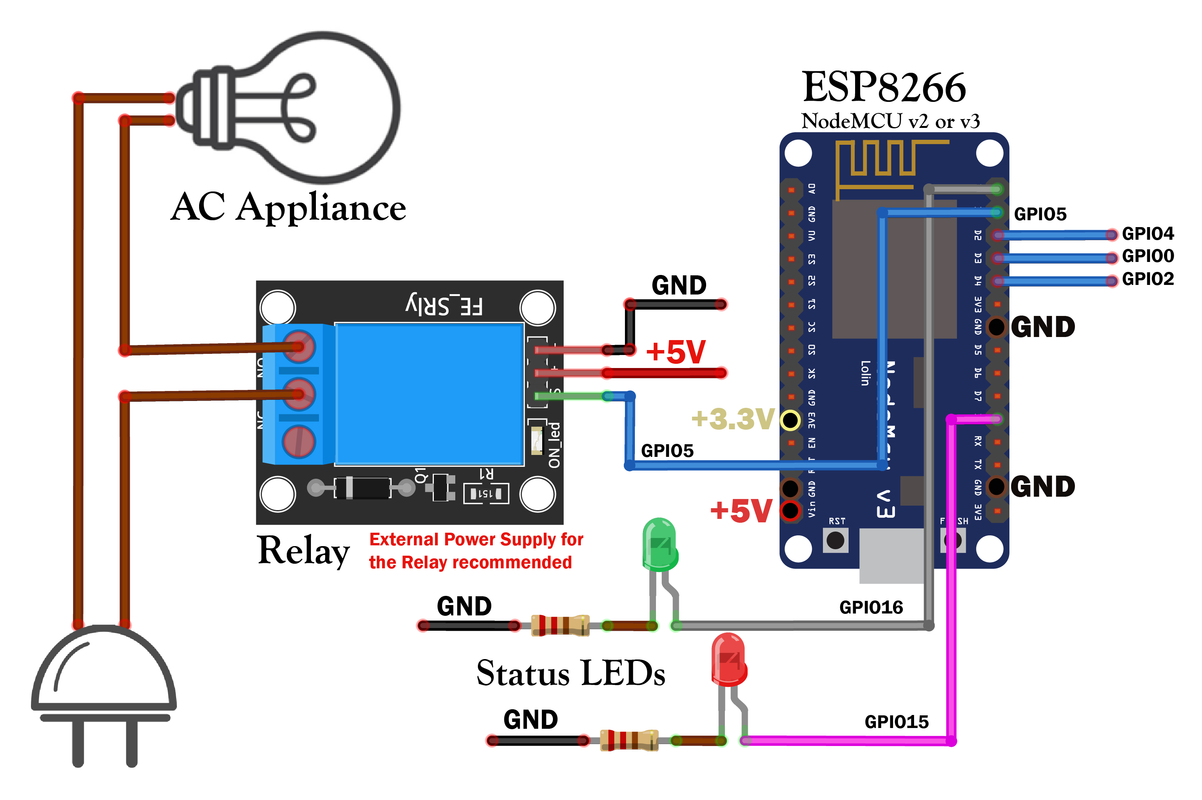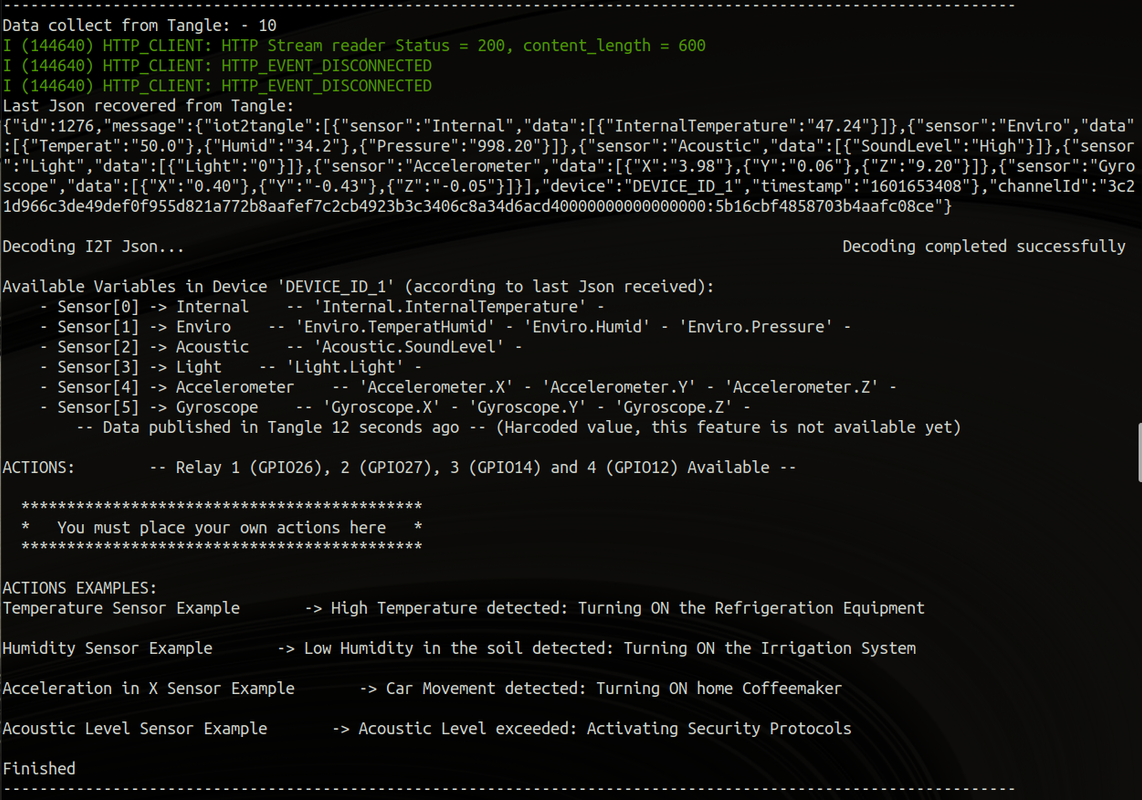This code will allow you to collect information/data from the Tangle (Streams Channel) that was or is being sent from a sending device and then decode the json data and save it in variables. This will allow you to execute actions according to the data that you are "sensing" in the sending device.
Currently the code is optimized to work by requesting data to Keepy. https://github.com/iot2tangle/Keepy
A simple example to illustrate the idea: Your sending device measures ambient temperature in your garden, and sends that data to Tangle, and you will have another device inside your house reading that json data from tangle, and at a certain temperature a relay is activated that turns on the mechanism of closing the windows of your house.
This is just an example, the code is prepared to receive any type of data and you will have to write your code for the activation of the outputs/relays according to the conditions you need (it is not difficult at all and there are very useful examples for it in it code).
4 GPIO ESP8266 pins have been defined for the outputs. The outputs are Boolean: 1 or 0 (3.3V or 0V in voltage). Any device that takes advantage of these outputs can be connected, but without a doubt the ones that bring out the most potential to the application are the relays.
The default ESP8266 Outputs GPIOs are: Output/Relay 1 -> GPIO5 -- Output/Relay 2 -> GPIO4 -- Output/Relay 3 -> GPIO0 -- Output/Relay 4 -> GPIO2
It is quite possible that an external 5V source is needed to power the relays, as development boards generally do not have enough power to power a relay
IMPORTANT: The moment you start using Relays is when, for your safety, you should pay close attention to their electrical connections. Whenever you are going to make changes to the connection make sure you have disconnected the AC connector, otherwise there may be a risk of electrocution. The following link from Panasonic company has safety tips when handling Relays. Relays Cautions for Use - Panasonic
This repository uses the Iot2Tangle C Core receiver devices adapted for ESP8266-FreeRTOS offered in the official Espressif Toolchain ESP-IDF SDK. Once the SDK is installed you will have all the tools to compile and download the program on your ESP8266.
Remember that for ESP8266 to be taking data you must have a Keepy instance running on some endpoint that ESP8266 can reach.
The easiest way to install ESP-IDF and their prerequisites is to download the ESP-IDF Windows Environment and Toolchain installer from this URL: https://dl.espressif.com/dl/esp32_win32_msys2_environment_and_toolchain-20181001.zip
Unzip the zip file to C:\ (or some other location, but this guide assumes C:\) and it will create an msys32 directory with a pre-prepared environment.
Open a MSYS2 MINGW32 terminal window by running C:\msys32\mingw32.exe. The environment in this window is a bash shell. Create a directory named esp that is a default location to develop ESP8266 applications and then the ESP8266_RTOS_SDK will be cloned. To do so, run the following shell commands:
mkdir esp
cd esp
git clone --recursive https://github.com/espressif/ESP8266_RTOS_SDK.git
Before continuing you must add some Python libraries that were not added in the ESP-IDF Windows Toolchain, probably because they were added later. So, run the following shell commands:
pip install click
pip install pyelftools
Now install the SDK, this may take a while:
cd ESP8266_RTOS_SDK
./install.sh
. ./export.sh
After doing this last step do not close the shell, as we will compile and flash from here. If you close the shell you will have to do the previous step again.
Prerequisites of ESP-IDF SDK:
sudo apt update
sudo apt install git wget flex bison gperf python python-pip python-setuptools cmake ninja-build ccache libffi-dev libssl-dev libncurses5-dev libncursesw5-dev
It is recommended to install the lastest version, you can download it from here:
git clone --recursive https://github.com/espressif/ESP8266_RTOS_SDK.git
Now install the SDK, this may take a while:
cd ~/ESP8266_RTOS_SDK
./install.sh
. ./export.sh
After doing this last step do not close the shell, as we will compile and flash from here. If you close the shell you will have to do the previous step again.
You can download the repository directly from Github, or from shell or Command Prompt with the following command:
cd ~
git clone https://github.com/iot2tangle/ESP8266.git
cd ESP8266/http-receiver
The config.h file must be opened and modified, this file is in the directory 'ESP8266/http/main' of the repository.
This step is very important if you want to make a connection to the gateway. Your WiFi Credentials, the address and port that will have the I2T Keepy Host running, the Device Id, and others configurations. The Id Name Device you define here must be between the devices you set in on the Gateway configuration file.
/* Device */
const char* id_name = "ESP8266-Receiver";
/* Network Configuration */
const char* ssid_WiFi = "mySSID";
const char* pass_WiFi = "myPASS";
/* HTTP Endpoint Configuration */
const char* address = "YOUR_KEEPY_HOST/messages/last"; /* Endpoint address (HTTP), must NOT include 'http://xxx' or 'tcp://xxx', and must include '/messages/last' for using in I2T Keepy*/
int port = 3002;
/* Enable Relays */
bool isEnable_Relay_1 = true;
bool isEnable_Relay_2 = true; /* true: Enable -- false: Disable */
bool isEnable_Relay_3 = true;
bool isEnable_Relay_4 = true;
/* Interval of time */
long interval = 15; /* Time in seconds between */
4) Edit the 'action()' function of the file 'main/core/lib.c' to define the actions you want to perform.
For example:
float temperature = atof(j->sensor[1].value[0]); // atof() function converts string to float
printf("Temperature Sensor Example -> ");
if (temperature > 35.0) // If temperature is greater than 35 Celsius degrees, Turn on Refrigeration Equipment
{
set_relay_GPIO(0, 1); // Put in HIGH RELAY 1
printf("High Temperature detected: Turning ON the Refrigeration Equipment\n\n");
}
Remembering to have the ESP-IDF Toolchain open, and you make sure you are at the root of the http-receiver folder run the following command:
idf.py build
If the compilation was correct it should read: Project build complete.
Now make sure you have ESP32 connected to your computer, and know what COM port it is connected to. (You can see this in 'Device Manager').
Then run the following command that will start flashing the firmware. (You will probably have to press the reset button on your ESP8266 development board, even several times for it to recognize the board.)
idf.py -p COM1 flash # COM1 is an Windows port example, you must put your port. In Linux /dev/ttyUSB0 is an example, and in macOS: '/dev/cu'
Upon completion, the firmware is downloaded to your ESP8266. If the Keepy is configured correctly you will reading data from Tangle via Streams and executing actions from there.
If configured correctly, ESP8266 should be getting data from Keepy automatically. However, you may want to verify that it is running on ESP8266.
The code continuously sends information out the serial port, so it can read the serial port to see what is happening and detect errors.
You can use the 'Arduino Serial Monitor' for this, but we recommend using the following software:
Open Command Prompt.
Configure the Baud Rate of the port to 115200 bps:
mode COM1: baud=115200
Read the serial port:
copy COM1: con:
Install cu Monitor. It is an excellent shell monitor and very useful.
sudo apt install cu
Run cu Monitor:
cu -l /dev/ttyUSB0 -s 115200
The following screenshot is a reading of the Serial Port, you should see something like this:
You can run the available examples quickly by sending the following json which will activate all 4 relays:
curl --location --request POST 'YOUR-KEEPY-HOST:3002/messages' --header 'Content-Type: application/json' --data-raw '{"iot2tangle":[{"sensor":"Internal","data":[{"InternalTemperature":"47.24"}]},{"sensor":"Environmental","data":[{"Temperature":"62.3"},{"Humidity":"34.2"},{"Pressure":"998.20"}]},{"sensor":"Acoustic","data":[{"SoundLevel":"High"}]},{"sensor":"Light","data":[{"Light":"32"}]},{"sensor":"Accelerometer","data":[{"X":"3.98"},{"Y":"0.06"},{"Z":"9.20"}]},{"sensor":"Gyroscope","data":[{"X":"0.40"},{"Y":"-0.43"},{"Z":"-0.05"}]}],"device": "ESP32-Receiver","timestamp": "1601653408"}'
and the following command will deactivate them since it changes the values of the sensors:
curl --location --request POST 'YOUR-KEEPY-HOST:3002/messages' --header 'Content-Type: application/json' --data-raw '{"iot2tangle":[{"sensor":"Internal","data":[{"InternalTemperature":"47.24"}]},{"sensor":"Environmental","data":[{"Temperature":"12.5"},{"Humidity":"81.2"},{"Pressure":"998.20"}]},{"sensor":"Acoustic","data":[{"SoundLevel":"Low"}]},{"sensor":"Light","data":[{"Light":"32"}]},{"sensor":"Accelerometer","data":[{"X":"0.58"},{"Y":"0.06"},{"Z":"9.20"}]},{"sensor":"Gyroscope","data":[{"X":"0.40"},{"Y":"-0.43"},{"Z":"-0.05"}]}],"device": "ESP32-Receiver","timestamp": "1601653413"}'
{"iot2tangle":[{"sensor":"Internal","data":[{"InternalTemperature":47.24}]},{"sensor":"Environmental","data":[{"Temperature":"25.7"},{"Humidity":"34.2"},{"Pressure":"998.20"}]},{"sensor":"Accelerometer","data":[{"X":"3.98"},{"Y":"0.06"},{"Z":"9.20"}]},{"sensor":"Acoustic","data":[{"SoundLevel":"Low"}]}],"device": "ESP-HTTP","timestamp": "1601653408"}
The I2T Json Decoder uses a very simple and widely used in Embedded Systems Json library for C called jsmn https://github.com/zserge/jsmn. It is a very powerful tool and offers many decoding options and compatibility with all kinds of C types.
However, we have decided to use only some of its features and make a very simple decoder, so that it is very easy to modify. That is why our code decoder has the following limitations that must be met for correct code operation:
- Must be in IOT2TANGLE Json Standart format. Wiki/The-I2T-Json-standard
- Limited to 10 sensors and 16 values for each sensor. Although this can be expanded very easily if necessary.
- Sensor values must always be strings. That is, they must be enclosed in quotes ("). Then, they can be easily converted to integer, float or boolean as you can see in the examples.
- Arrays of any kind will not be recognized. Although the library allows to read arrays, it has not been implemented because it would complicate the code too much and it can be added very easily for a particular application.
- Sensor data will be saved ONLY if the sensor json object has the label "sensor".
- The sensor objects should be all together, and you should not put another json object in between because it will not give a good sensor reading.
- Preferably the batch of sensor objects should be the last ones, just before the 'device' label.
For inquiries, improvements or errors detected, please start an issue in this repository.

